最高のコレクション mna-sf score 139093
The MNASF contains six questions regarding (1) decrease in food intake, (2) weight loss, (3) mobility, (4) psychological distress or acute disease, (5) neuropsychological problems, and (6) body mass index The maximum score is 14 A score < 12 indicates a risk of malnutrition, and A total score of MNASF 11 indicates malnutrition, risk of malnutrition, and no malnutrition, respectively 23,26 Fried et al in 01 defined the frailty status based on five dimensions of frailty phenotype These criteria include shrinking, exhaustion, low levels of physical activity, weakness, and slowness12–14 normal nutritional status, 8–11 at risk of malnutrition and 0–7 malnourished The final MUST score is out of 6 and categorises;
Plos One The Screening Score Of Mini Nutritional Assessment Mna Is A Useful Routine Screening Tool For Malnutrition Risk In Patients On Maintenance Dialysis
Mna-sf score
Mna-sf score-J Nutr Health Aging 06;MNASF score may be better than the NRS02 score to recognize sarcopenia in Chinese geriatric population Both NRS02 and MNASF scores could predict mortality, but NRS02 score was the independent predict factor




Correlation Between Total Mna Score And 18 Items Of The Mna Among The Download Scientific Diagram
MUST and MNASF screening was undertaken by clinical staff according to instructions and scores recorded Scores were converted into categories for nutritional status using MUST and MNASF scoring criterit risk' (1 pointMUST, 8e11 MNASF) and10 ® Société des Produits Nestlé SA, Trademark OwnersB Store the completed MNASF® in the person s medical chart for future reference c Complete/update and implement an appropriate, personcentered, interdisciplinary plan of care, as per your organizations policy, based on the persons MNASF® score and your holistic assessment Evaluation 1 Unexpected outcomes a
The MNASF score can be performed easily and rapidly at bedside, and is thus an ideal screening tool to be used on a regular basis in the dialysis patient to detect patients at risk for malnutrition Malnutrition is a common problem in patients on dialysis, and is strongly associated with mortalityScreening score (max 14 points) 1214 points Normal nutritional status 811 points At risk of malnutrition 07 points Malnourished Last name First name Sex Age Weight, kg Height, cm Date Screening A Has food intake declined over the past 3 months due to loss of appetite, digestive problems, chewing or swallowing difficulties? The original MNASF was a combination of six questions from the full MNA A revised MNASF included calf circumference (CC) substituted for BMI performed equally well A revised threecategory scoring classification for this revised MNASF, using BMI and/or CC, had good sensitivity compared to the full MNA
A higher score on the MNASF significantly predicted a reduced risk of discharge to institution (adjusted OR=090 (95% CI=084;097), p=0003) Nutritional status, as measured by the MNASF, predicted discharge destination from an intermediate care56A M 3 Guigoz Y The MiniNutritional Assessment (MNA ®) Review of the Literature What does it tell us?≥3 points, frail A total score of MNASF 11 indicates malnutrition, risk of malnutrition, and no malnutrition, respectively



Http Www Mna Elderly Com Publications 4 Pdf
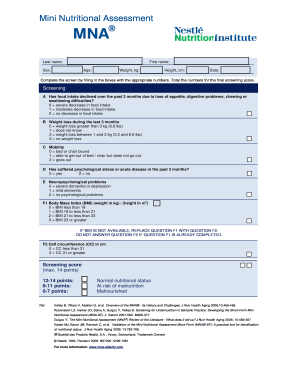



Mini Nutritional Assessment Fill Out And Sign Printable Pdf Template Signnow
A "MNASF template" was created on the electronic chart including assessment of each item with judgment criteria When information was entered into the template, a total score was automatically calculated and displayed Baseline cutoff values for the MNASF were 12–14 for "normal nutritional status",8–11 for "at The MNASF is the common tool for screening of nutritional status in the elderly10,42 The participants were classified in the normal nutritional status group if the MNASF total score was 12–14, at risk of malnutrition group if the MNASF total score was 8–11 and group if the malnourished group the MNASF total score was 0–75,6,8,10 TheThere was a significant correlation between MNASF and MNA (r = 8, p < 001), but a 24% mismatch in case dislocation was found using the atrisk or malnutrition criteria Factors related to obesity included male sex, higher MNASF and MNA scores, diabetes mellitus and hypertension, while acceptable discrimination for obesity (BMI≧23 kg/m 2




Predictability Of A Modified Mini Nutritional Assessment Version On Six Month And One Year Mortality In Hospitalized Geriatric Patients A Comparative Analysis Scientific Reports
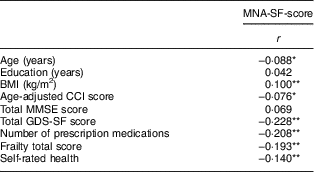



Health Determinants Of Nutritional Status In Community Dwelling Older Population The Verisaude Study Public Health Nutrition Cambridge Core
Australian, Brazilian, English, Iranian, and Norwegian(MNA®SF) The MNA®SF is a screening tool to help identify elderly patients who are malnourished or at risk of malnutrition The User Guide will assist you in completing the MNA®SF accurately and consistently It explains each questionMNASF scores and nutritional status according to these three measures were compared RESULTS Mean age and median MNASF scores of the patients were 75±76 years and 12 points (minmax 014) respectively There were strongly positive correlations between MNASF scores with BMI and CC, with BMI and HGS, and with CC and HGS (r=0938 p




Table 1 From Simplifications Of The Mini Nutritional Assessment Short Form Are Predictive Of Mortality Among Hospitalized Young And Middle Aged Adults Semantic Scholar




Uso Del Mini Nutritional Assessment Como Herramienta De Cribaje Nutricional En La Poblacion Mayor De 65 Anos En El Ambito Hospitalario Conveniencia Y Factibilidad
MNA scores ≤ 235 for the full MNA, or ≤11 for the MNASF were considered as at risk of malnutrition Figure 1 shows the flowchart of the Taiwan Longitudinal Survey on Aging (TLSA) Figure 2 shows the receiver operating characteristic (ROC) curves for the MNAT2 and MNAT2SF in predicting falling in 3118 ≥ 53year old Taiwanese As for the distribution of the MNASF score among the patients, 334 of the sample had scores of 0–7 points, 393% had scores of 8–11 points, and 273% had scores of 12–14 points According to the MNASF classification, 334%, of the patients in this study were malnourished, 393% were at nutritional risk, and 273% were classified as The final MNASF score is out of 14 and can be converted into categories of nutritional risk;




Pdf The Screening Score Of Mini Nutritional Assessment Mna Is A Useful Routine Screening Tool For Malnutrition Risk In Patients On Maintenance Dialysis Semantic Scholar
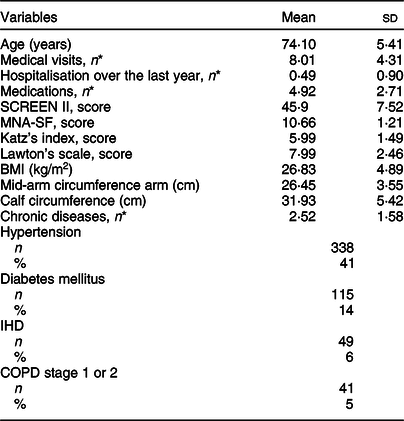



Comparison Of Seniors In The Community Risk Evaluation For Eating And Nutrition Version Ii And Mini Nutritional Assessment Short Form In Detecting Nutritional Risk Among Community Dwelling Seniors In Bosnia And Herzegovina
Max score = 30;MNASF consists of 6 items food intake decline, weight loss, mobility, suffering from psychological stress or acute disease, Neuropsychological problems, and BMI We performed Cox proportional regression analysis to examine the association of MNASF score with 30month mortality Results Mean MNASF score was ± 22 Sensitivity refers to the proportion of older adults who experience malnutrition (MNASF score 0–7) or risk of malnutrition (MNASF score 8–11) and who are correctly classified as such whereas specificity refers to those who do not experience malnutrition (MNASF score 12–14) and are correctly classified




Evaluation Of The Mini Nutritional Assessment Short Form Mna Sf




Table 4 From Estimated Height From Knee Height In Caucasian Elderly Implications On Nutritional Status By Mini Nutritional Assessment Semantic Scholar
The mean MNASF score was 99±18, with 301%, 593% and 106% of patients categorized as having normal nutritional status, at risk for malnutrition and malnourished, respectively The screening score was associated with mortality (HR 086, 95% CI per point) MNA®SF scores were significantly lower in the deceased residents than survivors • After adjusting for confounders, MNA®SF score was associated with mortality • MNA®SF is an effective predictor of mortality in nursing homes in Japan The MNASF is the common tool for screening of nutritional status in the elderly 10,42 The participants were classified in the normal nutritional status group if the MNASF total score was 12–14, at risk of malnutrition group if the MNASF total score was 8–11 and group if the malnourished group the MNASF total score was 0–7 5,6,8,10
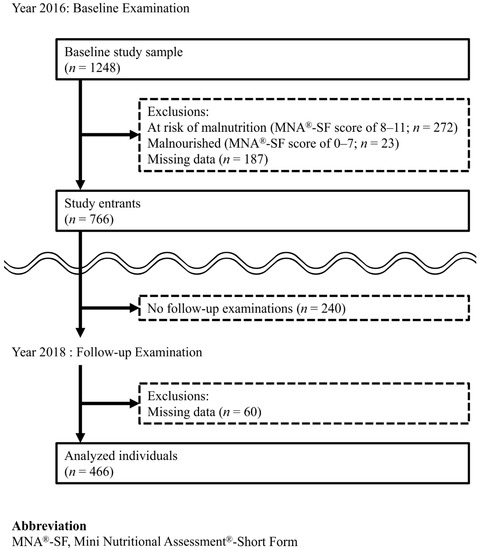



Ijerph Free Full Text A Two Year Longitudinal Study Of The Association Between Oral Frailty And Deteriorating Nutritional Status Among Community Dwelling Older Adults Html




Pdf Screening For Undernutrition In Geriatric Practice Developing The Short Form Mini Nutritional Assessment Mna Sf
A score of 12 to 14 indicates normal nutritional status, 8 to 11 indicates at riskAssessment Short Form (MNASF) is a screening tool used to identify older adults (>60 years) who are malnourished or at risk of malnutrition The MNA or MNASF is a noninvasive and inexpensive practical evaluation instrument which provides a simple, quick method of identifying older adults who are at risk of malnutritionScored 0–14) (Supplemental Table 1c) The MNA was developed in 1996 as a tool to identify malnutrition in elderly patients The MNASF , a shorter version of MNA, consists of 6 questions that assess food intake, weight loss, mobility, acute events, neuropsychological problems, and BMI Subjects with an MNASF score of 12–14 have normal nutritional status, and those with an MNASF score



1




Evaluation Of The Efficacy Of Nutritional Screening Tools To Predict Malnutrition In The Elderly At A Geriatric Care Hospital Abstract Europe Pmc
The MNASF is an interactive activity/questionnaire that is comprised of 6 items rated between 0 to 3 relative to aspects of subject's nutritional intake Scores can range from 0 to 14 with lower scores considered more problematicOne point is assigned for each criterion, and frailty status is identified based on the number of points scored 0 points, not frail; The mean MNASF score was 11 ± 2 points (range 4–14 points), with 35 patients (4%) classified as malnourished, 361 patients (40%) atrisk for malnutrition and 512 (56%) subjects with a normal nutritional status Table 1 shows baseline characteristics of the study population




The Relation Of Mini Nutritional Screening Score Subjective
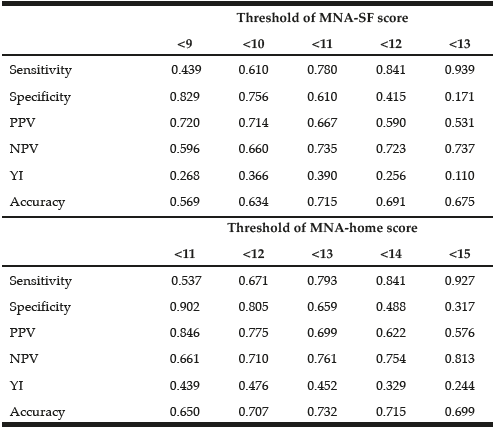



Modification Of The Mna Sf For Community Dwelling Older Adults At Risk Of Malnutrition Jarlife
The agreement between the MNASF score and the GLIM criteria were observed in only 223% of the population The sensitivity and specificity of MNASF against the GLIM criteria were fair (592% and 7%, respectively) The area under the curve (AUC) was 077, indicating the fair ability of MNASF to diagnose malnutrition We derived the MNASF score from available data collected in the SLAS1 cohort as previously reported 10 The total weighted MNASF score ranges from 0 to 14; Mini Nutritional Assessment–Short Form (MNASF;




Distribution Of Mna Sf Scores By Malnutrition Risk Status Download Scientific Diagram



1
1 MIS, malnutrition inflammation score; as a shortform MNA (MNASF) are available The complete MNA includes eighteen items in four domains (AppendixA) The MNASF includes only six items, but is quicker and as e ective as the long version If the total score is 11 points or less, the patient isLong Form MNA and Short Form MNASF versions included in this summary;
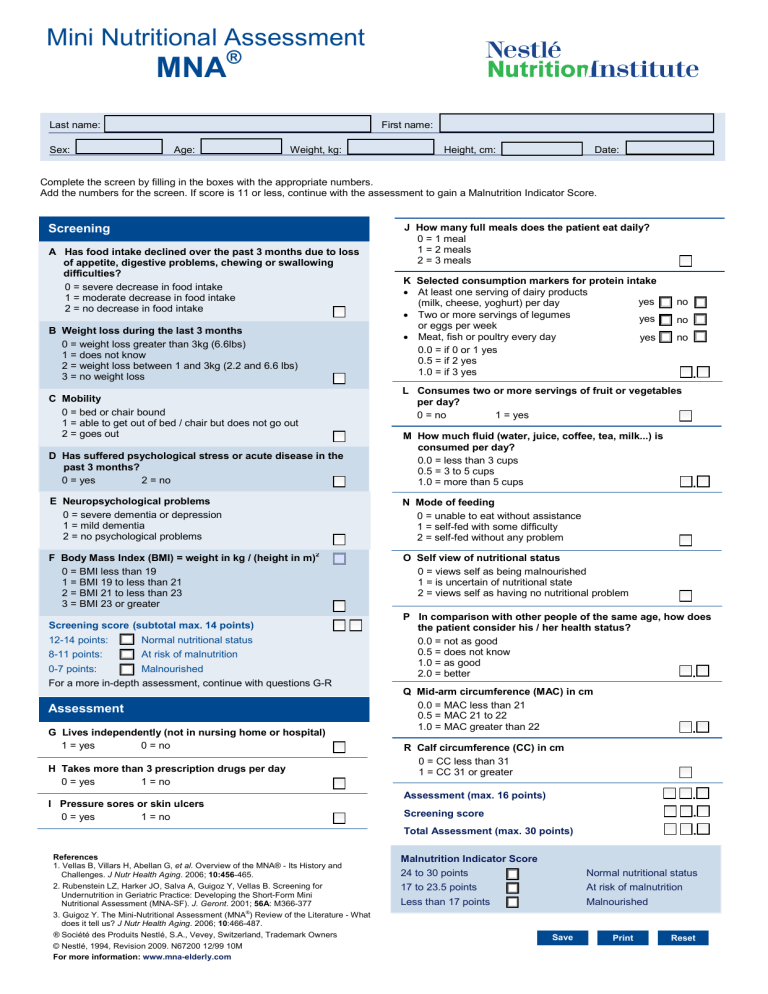



Mini Nutritional Assessment




Table 5 From Simplifications Of The Mini Nutritional Assessment Short Form Are Predictive Of Mortality Among Hospitalized Young And Middle Aged Adults Semantic Scholar
MNASF, Mini Nutritional Assessment–Short Form;MUST, Malnutrition Universal Screening ToolAdd the numbers for the screen If score is 11 or less, continue with the assessment to gain a Malnutrition Indicator Score Screening Assessment Malnutrition Indicator Score 24 to 30 points Normal nutritional status 17 to 235 pointsRubenstein At risk of malnutrition



Http Www Mna Elderly Com Mna Proceedings Pdf




Short Form Nestle Mini Nutritional Assessment Mna C Nestle 1994 Download Scientific Diagram
MNASF score ≤7 and total energy intake ≤245 kcal/kg/day predicted functional dependence at discharge with moderate sensitivity and specificity Conclusions MNASF score and total energy intake at the commencement of CR are novel predictors of the extent of functional recovery of elderly HF inpatients after inhospital CR The maximum score is 14 and the MNASF categorization is malnourished (scores 0–7), at risk of malnutrition (scores 8–11) and having normal nutritional status (scores Purpose We evaluated the outcomes of decitabine as firstline treatment in older patients with acute myeloid leukemia (AML) and investigated the predictors, including a baseline mini nutritional assessment short form (MNASF) score, of response and survival Patients and methods Between 10 and 18, 96 AML patients aged 65 and above who received decitabine




The Relation Of Mini Nutritional Screening Score Subjective



Www Nestlehealthscience In Sites G Files Dnigna226 Files Asset Library Documents Newsroom 4 Juergen Bauer Final Pdf
Mini Nutritional Assessment – Short Form (MNA®SF) The MNA®SF is a screening tool to help identify elderly patients who are malnourished or at risk of malnutrition This User Guide will assist you in completing the MNA®SF accurately and consistently It explains each question and how to assign and interpret the score IntroductionImportant When the Calf Circumference is used to complete the MNA®SF, do not use the full MNA® Otherwise, the full MNA® score will be inaccurate due to the Calf Circumference measurement being counted twice – once in the MNA®SF and again in Question R of the full MNA® Screening Score (Max 14 points)A Document the persons anthropometric data and MNASF score b Determine and chart the person's nutritional status based on their MNASF score Evaluation 1 Review history and MNASF findings Note areas of concern 2 Compare the person's weight and height with ideal and usual weight 3 Review anthropometric data against normal measurements and



Q Tbn And9gcry0bcfr3qe1e Xuzitzg4va Aoiiqcgxzvkqgqjco7lbxopqm8 Usqp Cau



1
NRS, nutritional risk score;Association between MNASF score and malnutrition did not improve the model fit Conclusions Combining risk screening tools may improve the accuracy of assessing an individual's risk of hospitalrelated harm, particularly falls, without increasing the amount of data to be collectedNourishment levels range from malnutrition (less than 17), risk of malnutrition (), normal nutritional status (2430) Questions are weighted, 23 points per item;




Predictive Value Of Nutritional Risk Screening 02 And Mini Nutrition Cia



Http Www Mna Elderly Com Mna Proceedings Pdf
Validation of the Mini Nutritional Assessment shortform (MNASF) a practical tool for identification of nutritional status The newly revised MNASF is a valid nutritional screening tool applicable to geriatric health care professionals with the option ofMNASF), for the nutritional assessment of the participants We used the full MNA as the gold standard for nutritional assessment The full MNA scale has 18 items, provides a maximum possible overall assessment of possible score is 14 points and, based on this score, there are three nutritional categories Item scores are summed;



Http Www Mna Elderly Com Publications 415 Pdf



Www Researchsquare Com Article Rs V1 Pdf C
MNA®SF score and with a normal serum albumin level will receive a phone call from the RD and will only receive a followup inperson visit if the RD believes it is necessary Version 80 (10/2/15) 115, 151 The protocol was revised to reflect changes in the way adjudication will be performed The mean scores we obtained in the three scales are high and are very similar in the two short scales Out of a possible 14 points offered by both versions, the elderly respondents achieved an average score of 124 points (SD = 16) on the BMIMNASF scale and 123 points (SD = 17) on the CCMNASF scaleGeriatric Practice Developing the ShortForm Mini Nutritional Assessment (MNASF) J Geront 01;



Http Citeseerx Ist Psu Edu Viewdoc Download Doi 10 1 1 2 19 Rep Rep1 Type Pdf




Distribution Of Mna Sf Scores By Malnutrition Risk Status Download Scientific Diagram



Www Mna Elderly Com Forms Mna Guide English Pdf
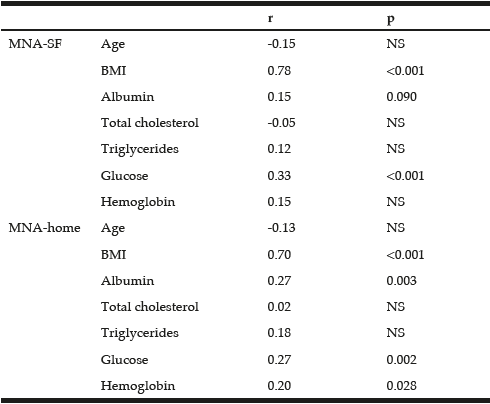



Modification Of The Mna Sf For Community Dwelling Older Adults At Risk Of Malnutrition Jarlife




A Total Score On The Mna Sf For The Vital Participants That Were Download Scientific Diagram




Table 4 From Simplifications Of The Mini Nutritional Assessment Short Form Are Predictive Of Mortality Among Hospitalized Young And Middle Aged Adults Semantic Scholar




Spearman Correlation Coefficients Of Mna Sf And Nrs02 Scores With Download Table
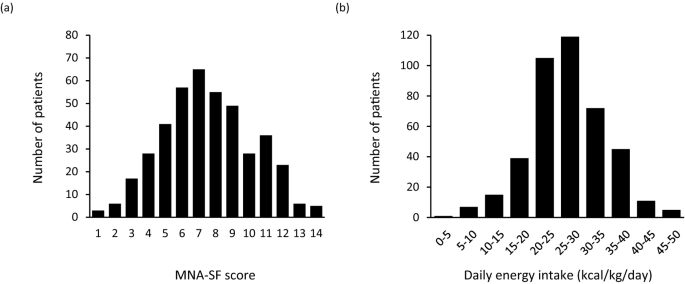



Energy Intake During Hospital Stay Predicts All Cause Mortality After Discharge Independently Of Nutritional Status In Elderly Heart Failure Patients Springerlink



Www Mna Elderly Com Forms Mna Guide English Sf Pdf
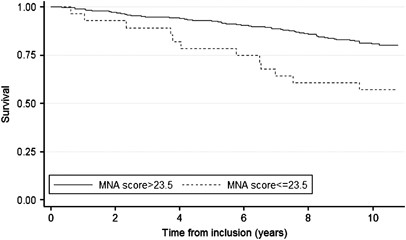



Mini Nutritional Assessment And 10 Year Mortality In Free Living Elderly Women A Prospective Cohort Study With 10 Year Follow Up European Journal Of Clinical Nutrition



Http Www Mna Elderly Com Mna Proceedings Pdf



The Screening Score Of Mini Nutritional Assessment Mna Is A Useful Routine Screening Tool For Malnutrition Risk In Patients On Maintenance Dialysis
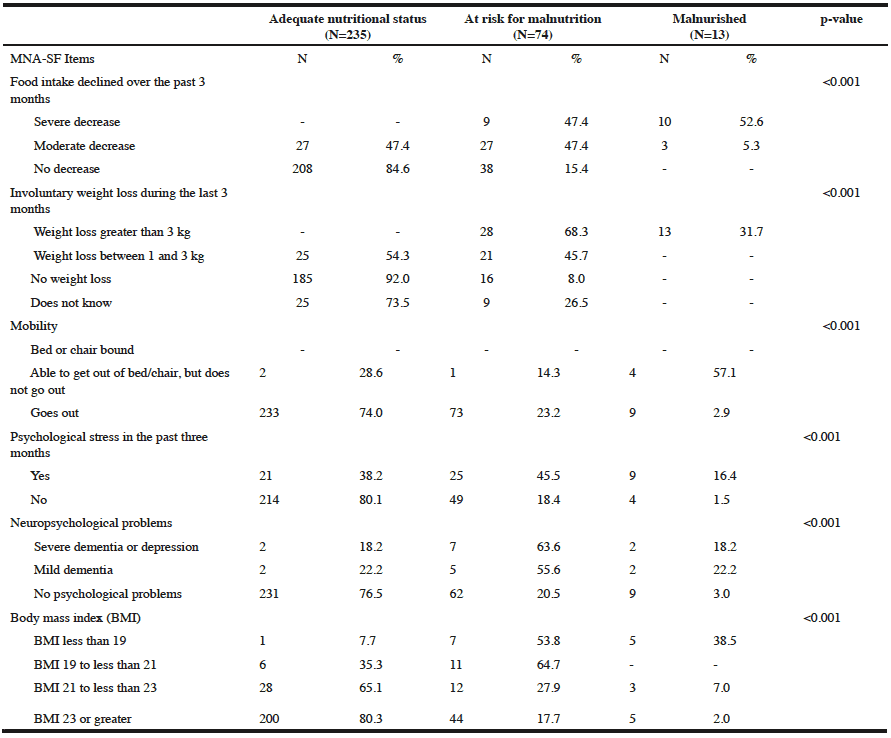



Short Form Mini Nutritional Assessment As A Tool For Nutrition Evaluation In Elderly Individuals With Cancer In Brazil Jarlife




Malnutrition In The Elderly Underrecognized And Increasing In Prevalence Page 2 Of 3 Clinical Advisor
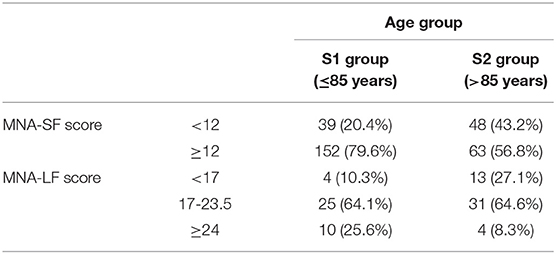



Frontiers Mini Nutritional Assessment Scores Indicate Higher Risk For Prospective Mortality And Contrasting Correlation With Age Related Epigenetic Biomarkers Endocrinology




Mini Nutritional Assessment Rehabmeasures Database
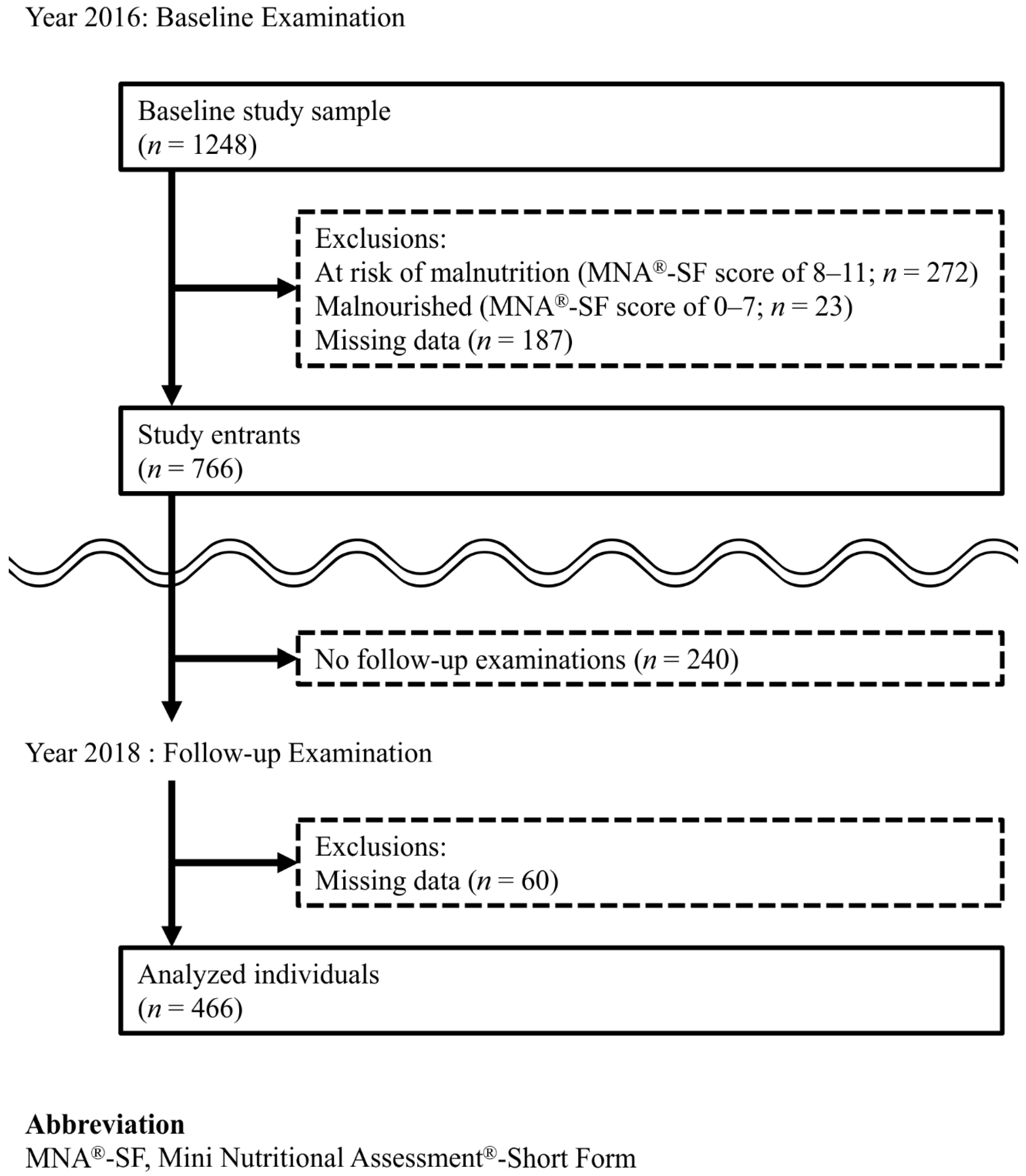



Ijerph Free Full Text A Two Year Longitudinal Study Of The Association Between Oral Frailty And Deteriorating Nutritional Status Among Community Dwelling Older Adults Html




Energy Intake During Hospital Stay Predicts All Cause Mortality After Discharge Independently Of Nutritional Status In Elderly Heart Failure Patients Springerlink




Mini Nutritional Assessment Scale Short Form Can Be Useful For Frailty Cia



2




Table 3 From Clinical Study Of Mini Nutritional Assessment For Older Chinese Inpatients Semantic Scholar




Mna Sf As A Screening Tool For Malnutrition Diagnosed With The Glim Criteria In Older Persons With Cancer Springerlink




Mini Nutritional Assessment Mna Mini Nutritional Assessment Mna Pdf Pdf4pro




Mini Nutritional Assessment And Anthropometric Measurements Jmdh




Xmlinkhub
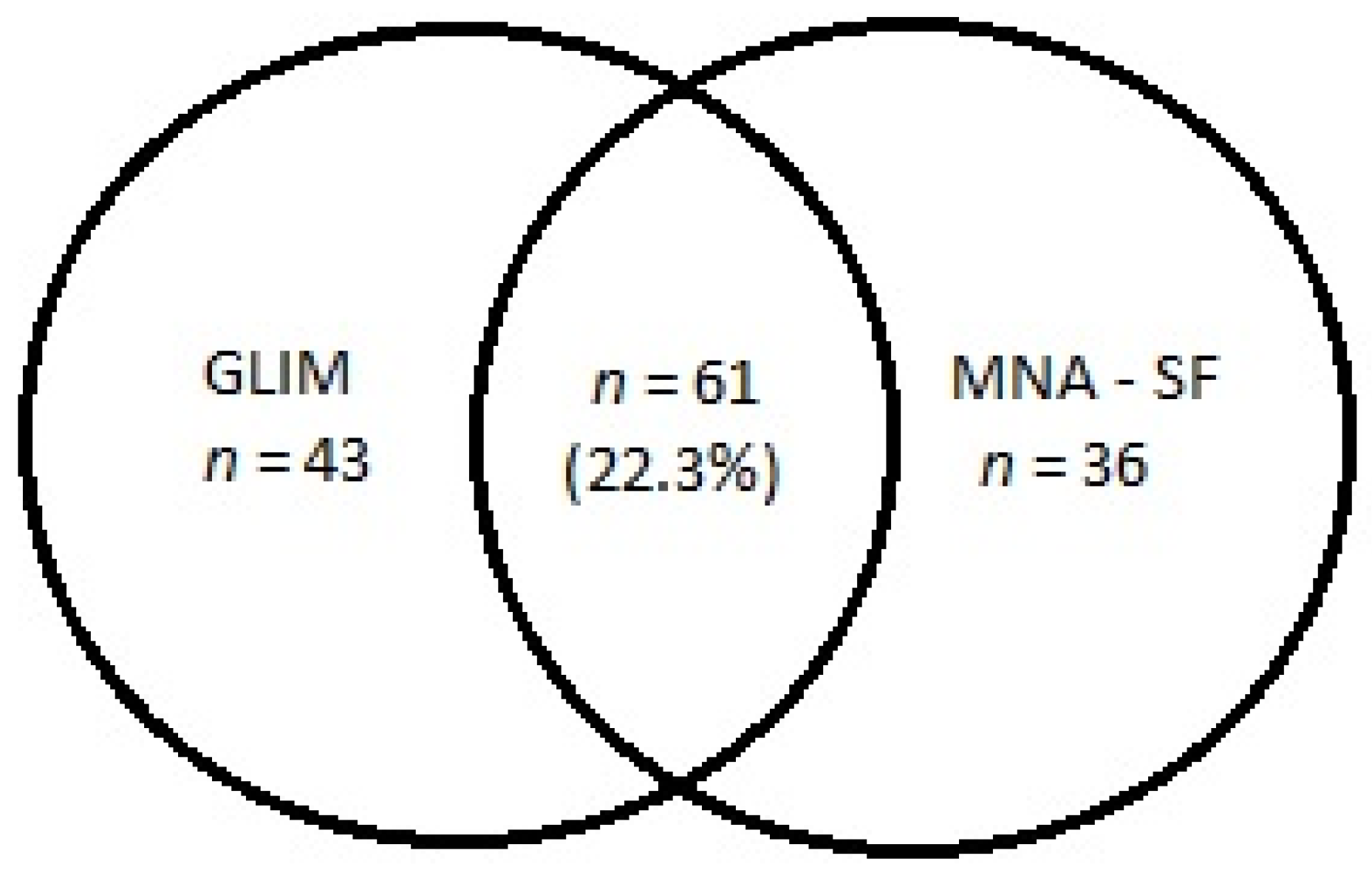



Nutrients Free Full Text Diagnostic Performance And Accuracy Of The Mna Sf Against Glim Criteria In Community Dwelling Older Adults From Poland Html



Plos One The Screening Score Of Mini Nutritional Assessment Mna Is A Useful Routine Screening Tool For Malnutrition Risk In Patients On Maintenance Dialysis




Impact Of Nutritional Education In Malnourished Elderly Patients With The Comparison Of Mini Nutritional Assessment Mna Score
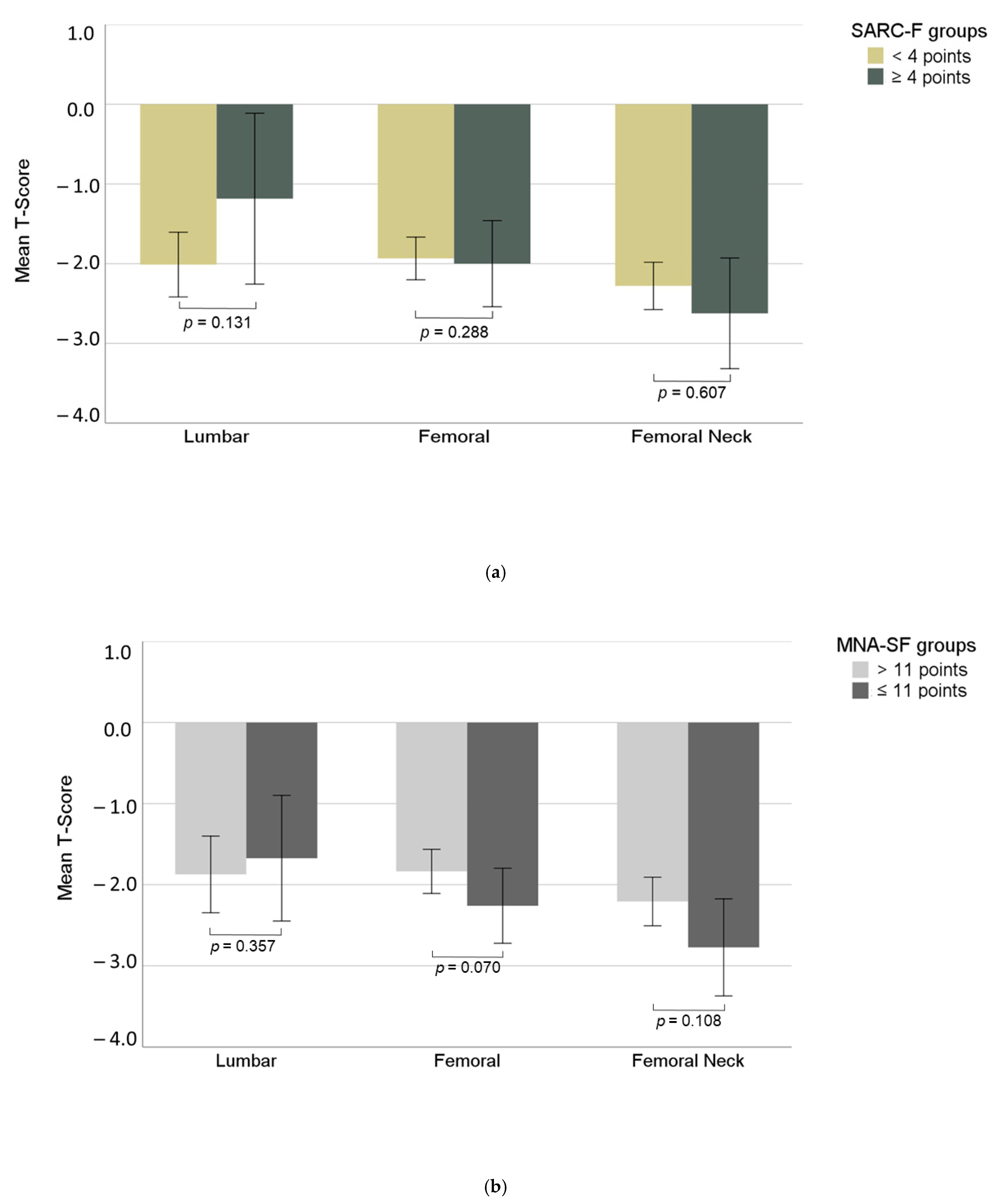



Jcm Free Full Text Sarcopenia And Malnutrition Screening In Female Osteoporosis Patients A Cross Sectional Study Html




Predictive Value Of Nutritional Risk Screening 02 And Mini Nutrition Cia




Agreement Between Mna Sf And Full Mna Download Table
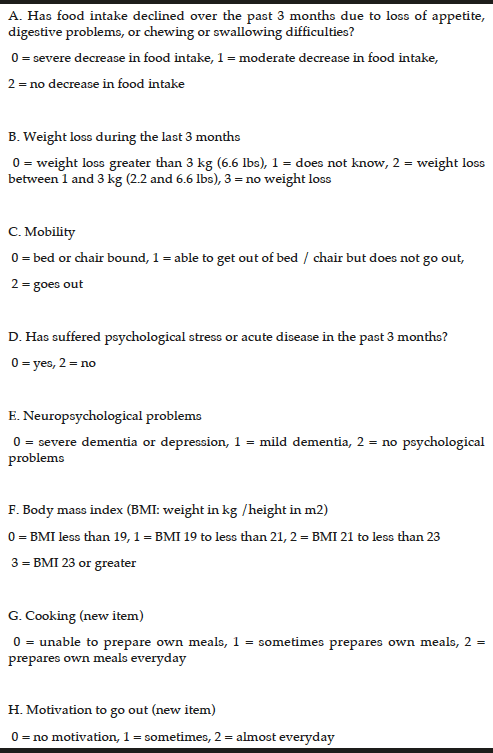



Modification Of The Mna Sf For Community Dwelling Older Adults At Risk Of Malnutrition Jarlife




Nutritional And Frailty State Transitions In The Singapore Longitudinal Aging Study Springerlink




Investigating The Prevalence Of Malnutrition Frailty And Physical Disability And The Association Between Them Amongst Older Care Home Residents Clinical Nutrition Espen



Plos One The Screening Score Of Mini Nutritional Assessment Mna Is A Useful Routine Screening Tool For Malnutrition Risk In Patients On Maintenance Dialysis



Plos One The Screening Score Of Mini Nutritional Assessment Mna Is A Useful Routine Screening Tool For Malnutrition Risk In Patients On Maintenance Dialysis




Identifying Geriatric Malnutrition In Nursing Practice The Mini Nutritional Assessment Mna An Evidence Based Screening Tool Journal Of Gerontological Nursing




Full Form Nestle Mini Nutritional Assessment Mna C Nestle 1994 Download Scientific Diagram




References In Malnutrition And Associated Factors In Elderly Hospital Patients A Belgian Cross Sectional Multi Centre Study Clinical Nutrition




Mna Skala
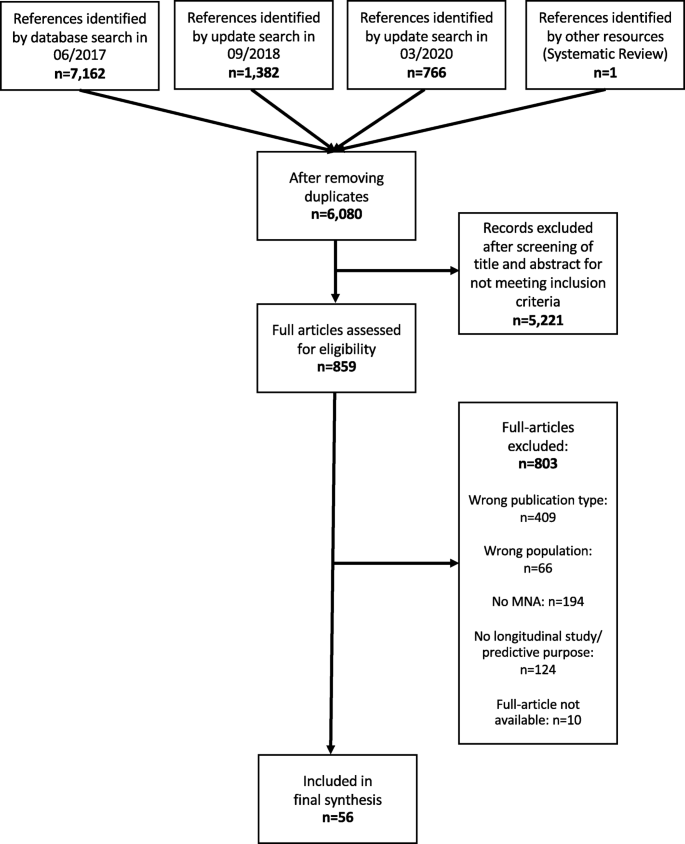



Nutritional Status According To The Mini Nutritional Assessment Mna As Potential Prognostic Factor For Health And Treatment Outcomes In Patients With Cancer A Systematic Review Bmc Cancer Full Text




Prognostic Value Of Mini Nutritional Assessment Short Form With Aortic Valve Stenosis Following Transcatheter Aortic Valve Implantation Doi Esc Heart Failure Wiley Online Library




Table 2 From Estimated Height From Knee Height In Caucasian Elderly Implications On Nutritional Status By Mini Nutritional Assessment Semantic Scholar




Participants Characteristics And Functioning By Their Mna Sf Download Table




Predictive Value Of The Mini Nutritional Assessment Short Form Mna Sf And Nutritional Risk Screening Nrs02 In Hip Fracture European Journal Of Clinical Nutrition



Www Mna Elderly Com Forms Mna Guide English Sf Pdf



Plos One The Screening Score Of Mini Nutritional Assessment Mna Is A Useful Routine Screening Tool For Malnutrition Risk In Patients On Maintenance Dialysis



2
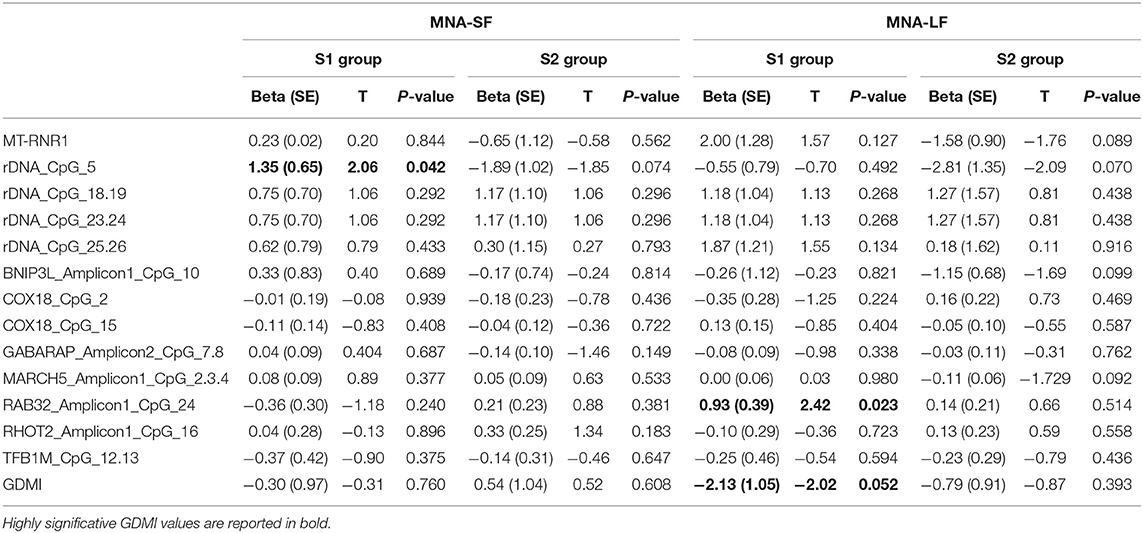



Frontiers Mini Nutritional Assessment Scores Indicate Higher Risk For Prospective Mortality And Contrasting Correlation With Age Related Epigenetic Biomarkers Endocrinology
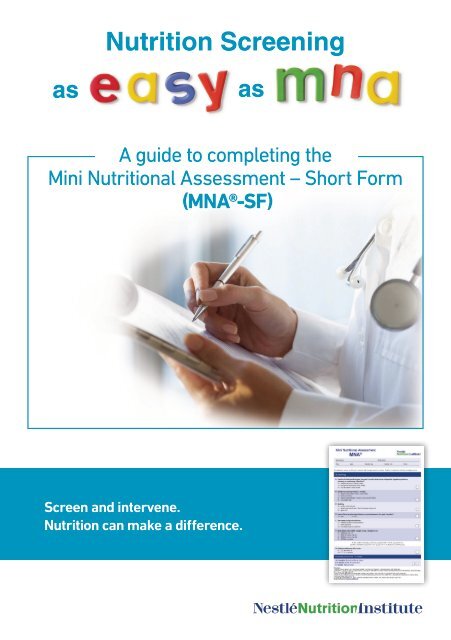



Nutrition Screening Mna Elderly



Http Www Swrwoundcareprogram Ca Uploads Contentdocuments Hcpr mna procedure Pdf




The Components Of The Mini Nutritional Assessment Short Form Mna Sf Download Table




A Review Of The Validity Of Malnutrition Screening Tools Used In Older Adults In Community And Healthcare Settings A Manuel Study Clinical Nutrition Espen
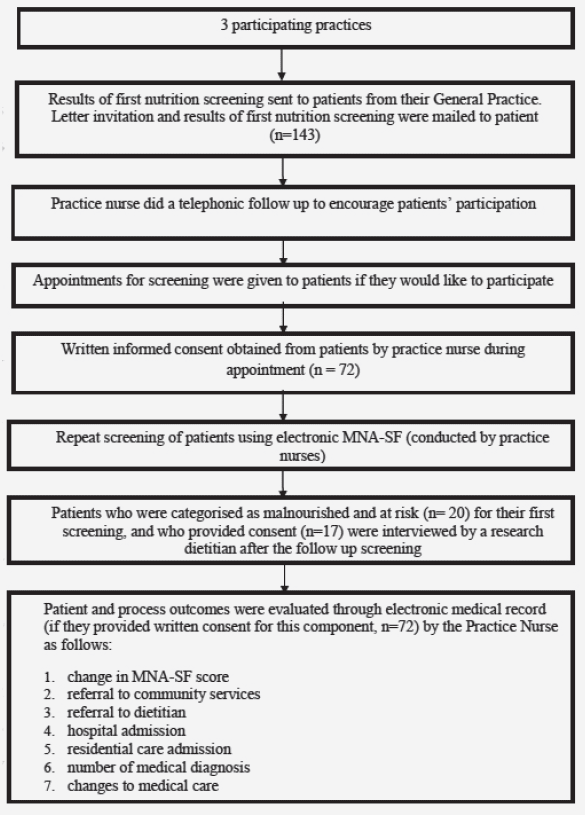



Implementation Of Nutrition Screening For Older Adults In General Practice Patient Perspectives Indicate Acceptability Jarlife




The Components Of The Mini Nutritional Assessment Short Form Mna Sf Download Table
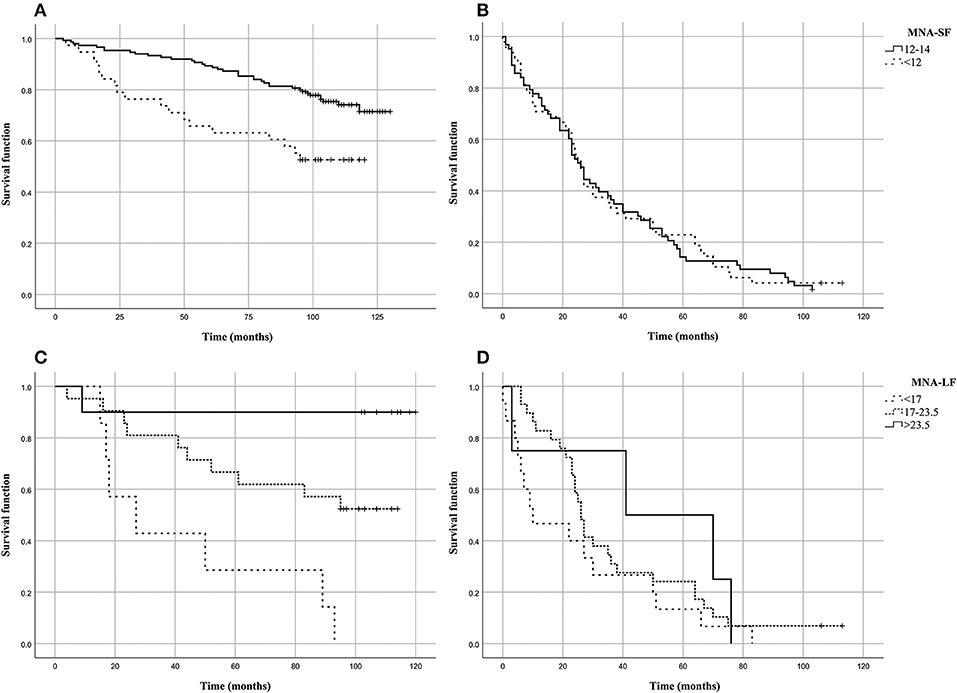



Frontiers Mini Nutritional Assessment Scores Indicate Higher Risk For Prospective Mortality And Contrasting Correlation With Age Related Epigenetic Biomarkers Endocrinology




Evaluation Of The Efficacy Of Nutritional Screening Tools To Predict Malnutrition In The Elderly At A Geriatric Care Hospital Abstract Europe Pmc
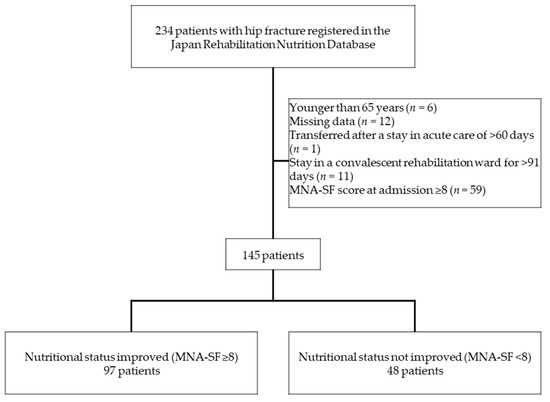



Healthcare Free Full Text Impact Of Rehabilitation Dose On Nutritional Status At Discharge From A Convalescent Rehabilitation Ward In Malnourished Patients With Hip Fracture Html



Http Www Hkcnaltd Org Hk Info Mna Pdf




The Role Of Early Nutrition Screening And Intervention In Lvad Therapy The Journal Of Heart And Lung Transplantation




Implementation Of Nutrition Screening For Older Adults In General Practice Patient Perspectives Indicate Acceptability Jarlife




Predictive Ability Of The Mini Nutritional Assessment Short Form Mna Sf In A Free Living Elderly Population A Cross Sectional Study Peerj
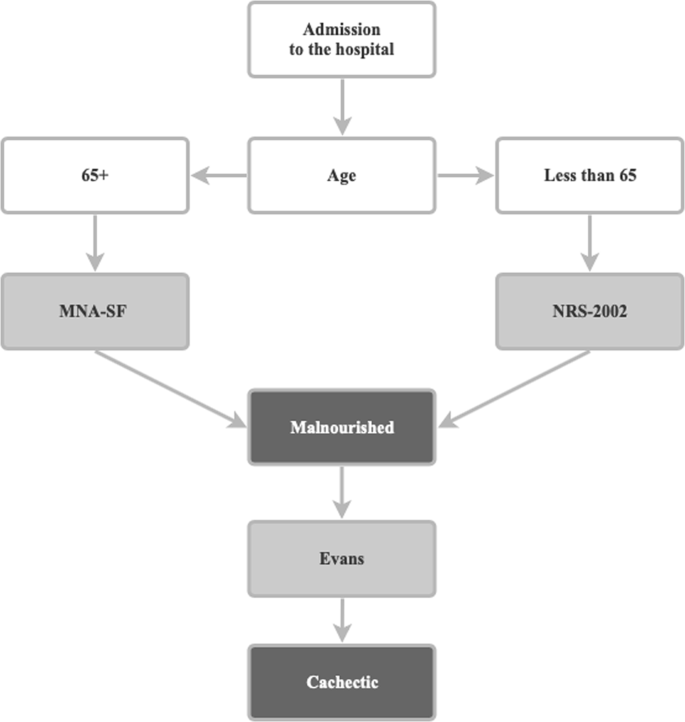



A Multi Center Survey On Hospital Malnutrition And Cachexia In Slovenia European Journal Of Clinical Nutrition




Correlation Between Total Mna Score And 18 Items Of The Mna Among The Download Scientific Diagram




Details Of Mna Sf Score Panel A Shows The Proportion Of Mna Sf Download Scientific Diagram




Analysis Of The Correlation Between Mna Mna Sf And Age Nutritional Download Table




Supplemental Materials For Association Between Separate Items Of The Mini Nutritional Assessment Instrument And Mortality Among Older Adults A Prospective Cohort Study Introducing A Trimmed Mna Version Clinical Nutrition




Agreement And Classification Performance Of Malnutrition Tools In Patients With Chronic Heart Failure Abstract Europe Pmc




Figure 1 From The Mini Nutritional Assessment Mna Review Of The Literature What Does It Tell Us Semantic Scholar




Predictive Validity Of Malnutrition Universal Screening Tool Must And Short Form Mini Nutritional Assessment Mna Sf In Terms Of Survival And Length Of Hospital Stay E Spen Journal



Www Nestlehealthscience In Sites G Files Dnigna226 Files Asset Library Documents Newsroom 4 Juergen Bauer Final Pdf



Core Ac Uk Download Pdf 6123 Pdf




Nutritional Assessment In Older Adults Mna 25 Years Of A Screening Tool A Reference Standard For Care And Research What Next Springerlink




Mini Nutritional Assessment Scale Short Form Can Be Useful For Frailty Cia


コメント
コメントを投稿